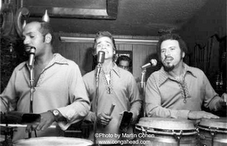
Like the old Morse Code, sound waves send messages out into space. In this fanciful premise, we claim that claves, with their asymmetrical rhythm, have a disruptive influence on the atomic celestial clock. The classic tick-tock, one-two, one-two beat is disturbed by the clave’s one, pause, one-two beat.
There are no events without the involvement of energy. Some planets release energy, such as the sun, while others both emit and receive energy, such as the earth. The sound waves of the claves disrupt the symmetrical flow of orderly emission of energy. The repetitious clack of the claves would hypnotize a listener if it were not for the pause that is its distinguishing feature. With this pause, the claves control the entire orchestra. If we were to modify our clocks to mimic the claves, replacing the regimented sound of seconds to the clave beat, we would syncopate the music of the spheres.
We humans are not sufficiently inspired by such possibilities. The magician employs a pause to achieve his trickiness. In that significant instant, he accomplishes his purpose. Nature may “hate a vacuum,” but the vacuum (read: the pause) exists for good reason. The claves involve man in the way the cosmos works. They may command the respect and control of the celestial orchestra, like a Toscanini. What is repetitive in clave rhythm can be called cyclical when applied to the cosmos. If life is both the teacher and the test, claves can be said to cheat, by not fitting the mold. Our learning never seems to fit into our lives properly.
The workings of cycles influence education itself and can, with their foreshadowing, show us the unseen, the unknown, and in that way achieve the goal of education. We mortals invite the sickness of misfortune by waving our fists in the face of the gods with our prideful approach to learning. The answer is in the claves: two simple wooden sticks.
There are no events without the involvement of energy. Some planets release energy, such as the sun, while others both emit and receive energy, such as the earth. The sound waves of the claves disrupt the symmetrical flow of orderly emission of energy. The repetitious clack of the claves would hypnotize a listener if it were not for the pause that is its distinguishing feature. With this pause, the claves control the entire orchestra. If we were to modify our clocks to mimic the claves, replacing the regimented sound of seconds to the clave beat, we would syncopate the music of the spheres.
We humans are not sufficiently inspired by such possibilities. The magician employs a pause to achieve his trickiness. In that significant instant, he accomplishes his purpose. Nature may “hate a vacuum,” but the vacuum (read: the pause) exists for good reason. The claves involve man in the way the cosmos works. They may command the respect and control of the celestial orchestra, like a Toscanini. What is repetitive in clave rhythm can be called cyclical when applied to the cosmos. If life is both the teacher and the test, claves can be said to cheat, by not fitting the mold. Our learning never seems to fit into our lives properly.
The workings of cycles influence education itself and can, with their foreshadowing, show us the unseen, the unknown, and in that way achieve the goal of education. We mortals invite the sickness of misfortune by waving our fists in the face of the gods with our prideful approach to learning. The answer is in the claves: two simple wooden sticks.


